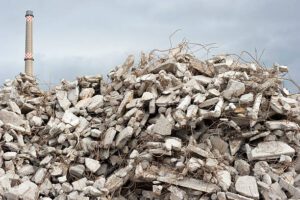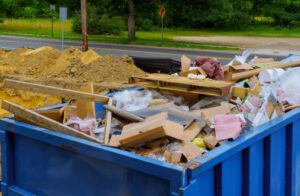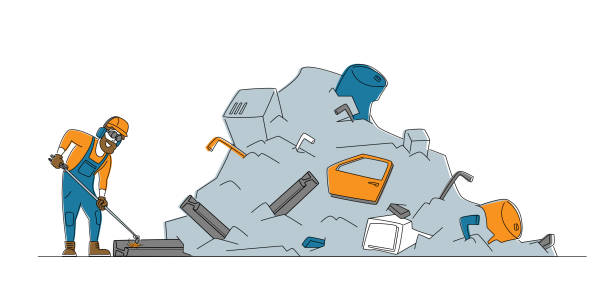Recycling in the construction industry has fast evolved from a wise financial decision to a necessity. In-depth research indicates that more than two billion tons of solid trash will be produced globally in 2025, with building projects potentially accounting for half of this total.
To put that into perspective, the World Bank discovered that in 2018, there was an astounding 3.7 pounds (1.68 kg) of construction-related rubbish produced for every person on the earth every day.
 (Photo from istock)
(Photo from istock)
It seems obvious that much more building and demolition recycling will be required in the near future given the high-profile challenges of declining landfill space, climate change, and the post-pandemic economy.
Every time, the advantages double: recycling plastic pipes not only prevents the ground from being filled with durable trash, but it also uses far less carbon than creating new items. Similar to this, recycling bricks from one project to the next reduces your need for new materials while also avoiding the rising cost of landfills.
Here are a few tips for managing construction waste to benefit your finances, reputation, and the environment:
-
Prepare beforehand
Before waste is even created, recycling and reuse may be accomplished for the majority of building and demolition projects. Planning is essential for building projects as it is for anything else. Compliance with the waste hierarchy is essential in decision-making, starting at the design stage. This entails giving reduction and reuse, recycling, and composting the first priority followed by energy recovery, then treatment, and ultimately disposal.
Neither should architects create plans that would produce unneeded waste at a high expense to the project and the environment. They wouldn’t design a building without taking occupant safety or comfort into account. Make sure everyone involved in the planning of a construction project, from the client to the subcontractors, considers strategies to reduce and effectively manage waste.
-
Avoid Waste by Preventing It
Simply by eliminating wasteful chances on a systematic basis, you can achieve huge gains. Similar to every other part of construction, this ability can be developed via repetition until it comes naturally.
Examining any plans for destruction thoroughly is a logical place to start when trying to reduce waste. Might the structure be demolished, preserved whole or in part, modified, or disassembled more delicately so that you might save more materials?
Consider carefully the addition of new materials to the website as well. Modern construction techniques, such offsite manufacturing and standardized components, can significantly reduce long-accepted inefficiencies.
-
Wherever possible, Reuse
 (Photo from istock)
(Photo from istock)
Almost all projects inevitably produce some construction and demolition debris. To determine what can be reused is the next stage. When you’re done heat-proofing the walls of an office building, you might have some mineral wall insulation. Find ways to incorporate these in other parts of the building or even at your future job.
In addition to like-for-like reuse, there are other chances to use surplus material in various ways. Have you thought of reducing leftover wood pieces for use as mulch in garden beds? Are there any nonprofits or volunteer groups in your community that will accept discarded materials like old doors and windows?
Boxes and pallets used for transport and packaging can frequently be returned to the vendor if they are kept in good shape. That improves ties with a significant supplier and reduces waste.
Your personnel and subcontractors should become as accustomed to a forensic approach to eliminating waste as they are to paying attention to other issues like cost savings and safety.
-
Differentiate and Recycle
Have a plan in place to recycle building and demolition waste if you can’t avoid it or utilize it again. On-site waste stream separation is frequently the first step in this process.
Each material type should have its own designated space on the site to facilitate site organization, promote responsible waste management, and, most importantly, increase the value of collected goods. It’s also a good idea to keep recyclable material in fair condition rather than allowing it to degrade into an uncontrollable puddle. Containers with covers and easy access are perfect.
It is now possible to recycle a variety of materials used in building and demolition, including numerous varieties of carpet, tiles, bricks, and blocks, as well as different grades of glass, plastic, and wood. The worth of these commodities to recycles will vary depending on variables like contamination levels, end markets, and the accessibility of reprocessing facilities.
Each project team will have to choose how finely to separate the trash. You may, for instance, decide to collect glass in a single container or divide it up into many bins according to hue or grade, depending on the size, volume, and collector requirements of the site. With regard to our next segment, it’s critical to go over recycling procedures with your collector.
-
Reserve Sensibly
 (Photo from istock)
(Photo from istock)
You must make sure that your waste materials are managed as best as possible after being segregated and stored. This entails having a contract for collection and disposal with a trustworthy business that can support your objective.
You will gain from the experience of a strong partner in this area. They can make sure you abide by local legislation, the waste hierarchy, and industry best practices. They will also aid you in overcoming any difficulties unique to your project and site. Importantly, they can transfer your loads for reuse and recycling as opposed to illegally dumping or land filling them.
Of course, procurement may assist in addressing waste from the very beginning of a project lifetime. Simultaneously, Where requirements permit, think about buying recycled materials to help the local recycling industry.
-
Evaluate and Celebrate Success
 (Photo from istock)
(Photo from istock)
Construction sites are hectic and perhaps such locations. And this will have to go further down the priority list.
Have plenty of visual clues to support the actions you want and make it as simple. As you can for individuals to act morally in order to keep the energy behind this crucial activity going.
Set the bar high, gather information on waste reduction, reuse, and recycling, demonstrate success in this area. It’s worth celebrating when recycling in construction increases.





13 Comments on “How to recycle and reuse construction waste”